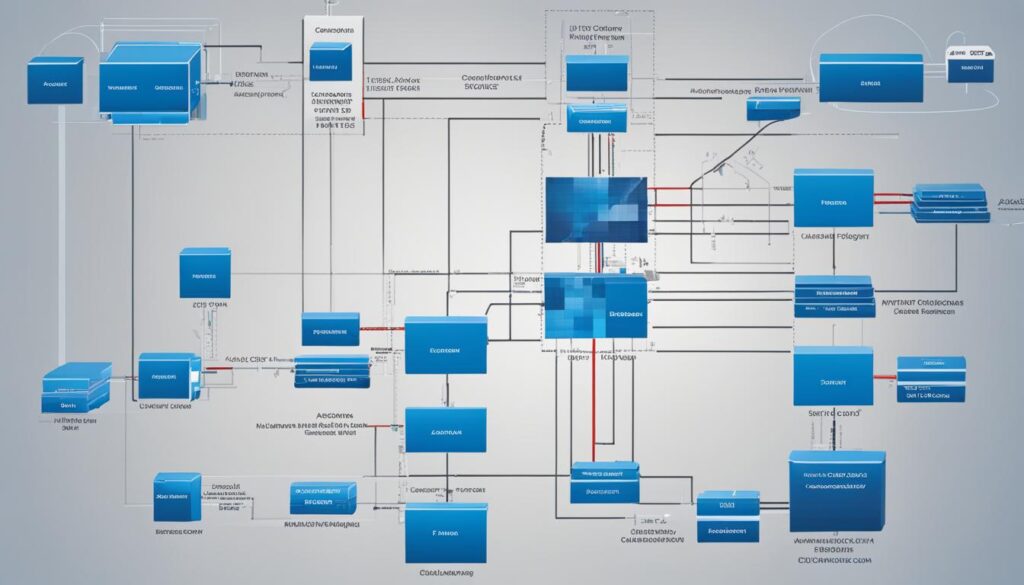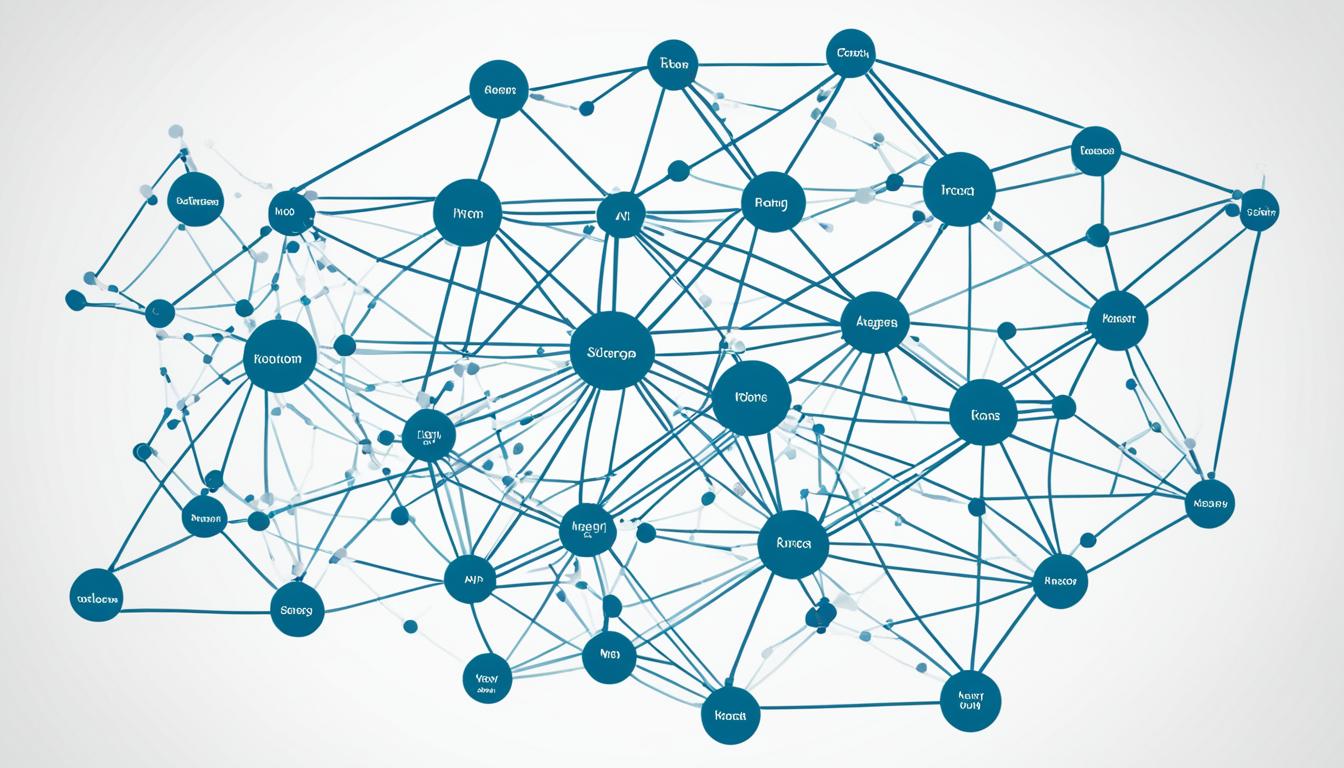Welcome to our comprehensive guide on Enterprise Integration Patterns (EIP) in Information Technology. In today’s interconnected world, seamless integration of software systems is crucial for businesses to thrive. EIP offers a catalog of design patterns that facilitate efficient system integration, enabling organizations to harness the power of enterprise-wide communication and collaboration.
Enterprise Integration Patterns provide standardized solutions to the challenges faced while integrating new and existing software in a business environment. With a collection of 65 design patterns, EIP includes a unique icon-based pattern language, often referred to as GregorGrams. These patterns primarily focus on messaging, allowing programs to communicate across different programming environments using a common messaging format and protocol.
The EIP architecture paves the way for streamlined communication and integration of enterprise systems. By facilitating seamless data flow and harmonious collaboration between various software components, EIP boosts efficiency and effectiveness, ultimately driving business success.
Contents
- 1 The Importance of EIP in Information Technology
- 2 Benefits of EIP in Information Technology
- 3 EIP Implementation Best Practices
- 4 Conclusion
- 5 FAQ
- 5.1 What is EIP in information technology?
- 5.2 What is EIP architecture?
- 5.3 How does EIP implementation benefit information technology?
- 5.4 What role does EIP middleware play in information technology?
- 5.5 What are the benefits of adopting EIP in information technology?
- 5.6 What are the best practices for EIP implementation?
- 6 Source Links
Key Takeaways:
- Enterprise Integration Patterns (EIP) enable efficient system integration in information technology.
- EIP provides a catalog of 65 design patterns, including a unique icon-based pattern language.
- EIP focuses on messaging patterns, allowing programs to communicate across different programming environments using a common messaging format and protocol.
- Implementing EIP architecture streamlines communication and integration of enterprise systems, leading to improved efficiency and effectiveness.
- EIP in information technology promotes seamless data flow and collaboration between various software components.
The Importance of EIP in Information Technology
The implementation of EIP in information technology is crucial for efficient system integration and communication. EIP enables the development of event-driven architecture, where software components respond to events in real-time, leading to faster and more accurate decision-making.
EIP middleware plays a critical role in facilitating messaging and communication between different software systems, ensuring seamless integration and data flow. Adopting EIP in information technology enables businesses to achieve greater agility, scalability, and responsiveness in their operations.
By leveraging EIP techniques, organizations can unlock numerous benefits, such as:
- Efficient system integration
- Real-time event-driven decision-making
- Seamless integration and data flow
- Improved agility, scalability, and responsiveness
EIP middleware acts as a bridge between various software components, enabling them to communicate and exchange data effectively. This allows businesses to leverage the power of event-driven architecture and respond swiftly to changing market conditions.
Implementing EIP in information technology is like building a finely-tuned engine that enables your systems to work in perfect harmony, delivering the performance and efficiency your business needs.
Let us take a closer look at the components that make EIP implementation a game-changer:
EIP Implementation
Implementing EIP involves designing and deploying an architecture that optimizes system integration. Key considerations during the implementation phase include:
- Choosing the appropriate EIP patterns for your specific integration requirements
- Designing a flexible and extensible EIP architecture to accommodate future changes and enhancements
- Ensuring performance, scalability, security, and compliance
- Thorough testing and ongoing monitoring to ensure smooth operation
By adhering to the best practices of EIP implementation, organizations can maximize the potential of this powerful integration approach and pave the way for future growth and innovation.
| Benefits of EIP Implementation | Description |
|---|---|
| Efficient System Integration | Streamlined communication and integration between different software systems, eliminating silos and improving overall efficiency. |
| Real-time event-driven decision-making | Faster response to critical events and the ability to make informed decisions in real-time for enhanced business operations. |
| Seamless integration and data flow | Efficient exchange of data between software components, ensuring smooth operations and achieving data consistency. |
| Improved agility, scalability, and responsiveness | Ability to adapt quickly to changing business needs, scale operations effortlessly, and respond promptly to market demands. |
Benefits of EIP in Information Technology
The adoption of Enterprise Integration Patterns (EIP) in information technology offers numerous benefits to organizations. EIP patterns provide standardized solutions that address common integration challenges, resulting in reduced development time and effort. By leveraging these patterns, businesses can streamline their integration processes and significantly improve efficiency.
An essential aspect of EIP is the messaging system, which enables reliable and asynchronous communication between distributed components. This ensures that messages are delivered and provides fault tolerance, enhancing the overall robustness of the system.
EIP introduces a high degree of flexibility, scalability, and reusability to software systems. With the implementation of EIP patterns, organizations can easily adapt to changing business needs and scale their systems as required. This agility allows for quicker response times and an increased ability to meet customer expectations.
Moreover, EIP promotes interoperability between different software systems, enabling seamless data exchange and collaboration. This interoperability plays a vital role in facilitating communication, both internally within an organization and externally with partners or clients.
“The adoption of EIP in information technology not only simplifies integration development but also enhances system efficiency and collaboration, ultimately driving business success.”
To further illustrate the benefits of EIP in information technology, let’s take a look at a comparison table:
| Benefits | EIP | Non-EIP |
|---|---|---|
| Standardized integration solutions | ✓ | ✗ |
| Reduced development time and effort | ✓ | ✗ |
| Reliable and fault-tolerant messaging | ✓ | ✗ |
| Flexibility and scalability | ✓ | ✗ |
| Improved interoperability | ✓ | ✗ |
As seen in the table above, EIP outperforms traditional non-EIP approaches in various aspects, providing organizations with a competitive advantage in today’s dynamic business landscape.

The adoption of EIP in information technology significantly empowers organizations to overcome integration challenges, optimize communication, and enhance collaboration.
The Next Section:
Section 4 of the article will dive into best practices for implementing EIP in information technology, ensuring a successful integration journey.
EIP Implementation Best Practices
When implementing EIP in information technology, following best practices is essential to ensure success. By carefully analyzing your integration requirements and choosing the most appropriate EIP patterns and architecture, you can optimize the effectiveness of your implementation.
One key aspect to consider is designing a flexible and extensible EIP architecture that can accommodate future changes and enhancements. This allows your system to evolve as your business needs grow, saving time and effort in the long run.
Additionally, organizations should consider several factors when implementing EIP:
- Performance: Ensure that your EIP implementation meets the performance requirements of your organization’s systems and processes.
- Scalability: Design your EIP architecture to handle increasing volumes of data and user interactions without sacrificing performance.
- Security: Implement robust security measures to protect sensitive data and prevent unauthorized access.
- Compliance: Ensure that your EIP implementation adheres to relevant industry regulations and standards.
Thorough testing and ongoing monitoring are also vital to ensure the smooth operation of your EIP systems. Regularly evaluating and optimizing your implementation will help identify and resolve any issues that may arise.
By following these best practices, you can maximize the benefits of EIP in your information technology infrastructure and facilitate seamless integration and communication between different software systems.
Example Table: EIP Implementation Considerations
| Consideration | Description |
|---|---|
| Integration Requirements Analysis | Thoroughly assess the integration needs of your organization to determine the most suitable EIP patterns and architecture. |
| Flexible and Extensible Architecture | Design an EIP architecture that can adapt to future changes and enhancements, ensuring scalability and cost-effectiveness. |
| Performance Optimization | Optimize the performance of your EIP implementation to meet the processing requirements of your organization’s systems and processes. |
| Scalability Planning | Consider future data growth and user interactions to design an EIP architecture that can scale without compromising performance. |
| Security Measures | Implement robust security measures to protect sensitive data and prevent unauthorized access. |
| Compliance Considerations | Ensure that your EIP implementation complies with relevant industry regulations and standards. |
| Thorough Testing | Perform comprehensive testing to identify and resolve any issues or bugs in your EIP systems. |
| Ongoing Monitoring | Continuously monitor your EIP implementation to ensure smooth operation and address any performance or security issues. |

Conclusion
In conclusion, Enterprise Integration Patterns (EIP) play a critical role in information technology by providing a catalog of design patterns for effective system integration. By implementing EIP, organizations can improve communication and integration between different software systems, leading to enhanced efficiency and productivity.
EIP offers numerous benefits, including standardized solutions to integration challenges, improved flexibility and scalability, and seamless data exchange. The adoption of EIP enables businesses to achieve greater agility, competitiveness, and innovation in a rapidly evolving digital landscape.
However, successful EIP implementation requires careful planning, consideration of best practices, and ongoing monitoring. By analyzing integration requirements, designing a flexible architecture, and addressing factors such as performance, scalability, security, and compliance, organizations can ensure the smooth operation of EIP systems. Continuous testing and monitoring are also vital to identifying and resolving any issues that may arise.
Embracing EIP in information technology empowers organizations to harness the full potential of system integration, enabling them to streamline operations, improve decision-making, and drive innovation. With its myriad benefits, EIP proves to be a valuable asset for businesses seeking to optimize their software systems and thrive in today’s digital landscape.
FAQ
What is EIP in information technology?
EIP stands for Enterprise Integration Patterns. It is a catalog of design patterns used to integrate new and existing software systems in a business environment.
What is EIP architecture?
EIP architecture focuses on messaging patterns for enterprise application integration, enabling programs to communicate across different programming environments using a common messaging format and protocol.
How does EIP implementation benefit information technology?
Implementing EIP enables the development of event-driven architecture, faster decision-making, and seamless integration and data flow between different software systems.
What role does EIP middleware play in information technology?
EIP middleware facilitates messaging and communication between different software systems, ensuring seamless integration and data flow.
What are the benefits of adopting EIP in information technology?
Adopting EIP provides standardized solutions to integration challenges, reliable and asynchronous communication, improved flexibility and scalability, and promotes interoperability between software systems.
What are the best practices for EIP implementation?
Best practices include analyzing integration requirements, choosing appropriate EIP patterns and architecture, designing a flexible and extensible EIP architecture, considering factors such as performance and security, and thorough testing and ongoing monitoring.




